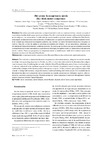Identificador persistente para citar o vincular este elemento:
https://accedacris.ulpgc.es/jspui/handle/10553/76942
| Campo DC | Valor | idioma |
|---|---|---|
| dc.contributor.author | Gómez Rijo, Antonio | en_US |
| dc.contributor.author | Fernández Cabrera, Jorge Miguel | en_US |
| dc.contributor.author | Hernandez Moreno,Jose Manuel | en_US |
| dc.contributor.author | Sosa Álvarez, Germán Sosa | en_US |
| dc.contributor.author | Pacheco Lara, Juan José | en_US |
| dc.date.accessioned | 2020-12-23T09:34:34Z | - |
| dc.date.available | 2020-12-23T09:34:34Z | - |
| dc.date.issued | 2020 | en_US |
| dc.identifier.issn | 1579-1726 | en_US |
| dc.identifier.other | Scopus | - |
| dc.identifier.uri | https://accedacris.ulpgc.es/handle/10553/76942 | - |
| dc.description.abstract | This work tries to characterize the motor competence as a theoretical construct, taking into account the scientific knowledge from a praxiological perspective. For this, we will try to determine what would be the dimensions that configure it and its characteristics. Considering that our study is linked to School Physical Education, motor behavior has been taken as its referent, understood as the significant organization of motor behavior. A qualitative research strategy was used, which combined the techniques of documentary analysis with a group of experts. For this, a semantic approximation analysis of the term and its background was made, using a documentary search methodology and content analysis. It is concluded that the dimensions that allow us to characterize motor competence as a specific competence are: biological, cognitive, affective, interactive, and motor or praxic execution. From this perspective, motor competence is manifested through motor behavior in motor situations of School Physical Education. | en_US |
| dc.description.abstract | Este artículo pretende caracterizar la competencia motriz como un constructo teórico, teniendo en cuenta el conocimiento científico desde una perspectiva praxiológica. Para ello, trataremos de determinar cuáles serían las dimensiones que la configuran y sus características. Considerando que nuestro estudio se pretende vincular a la Educación Física Escolar, se ha tomado la conducta motriz como su referente, entendida como la organización significativa del comportamiento motor. Se ha utilizado una estrategia de investigación cualitativa, que combinó las técnicas del análisis documental con grupo de expertos. Para ello, se hizo un análisis de aproximación semántica del término y de sus antecedentes, empleando una metodología de búsqueda documental y análisis de contenido. Se concluye que las dimensiones que nos permiten caracterizar la competencia motriz como una competencia específica son: la biológica, la cognitiva, la afectiva, la interactiva y la de ejecución motriz o práxica. Desde esta perspectiva, la competencia motriz se manifiesta por medio de la conducta motriz en las situaciones motrices de la Educación Física Escolar. | en_US |
| dc.language | eng | en_US |
| dc.relation.ispartof | Retos | en_US |
| dc.source | Retos [ISSN 1579-1726], n. 40, p. 375-384, (Noviembre 2020) | en_US |
| dc.subject | 61 Psicología | en_US |
| dc.subject | 610303 Asesoramiento y orientación educacional | en_US |
| dc.subject | 610204 Psicología escolar | en_US |
| dc.subject.other | Motor action | en_US |
| dc.subject.other | Motor behavior | en_US |
| dc.subject.other | Motor competence | en_US |
| dc.subject.other | Praxis significance | en_US |
| dc.subject.other | School physical education | en_US |
| dc.subject.other | Competencia motriz | en_US |
| dc.subject.other | Conducta motriz | en_US |
| dc.subject.other | Educación Física Escolar | en_US |
| dc.subject.other | Acción motriz | en_US |
| dc.subject.other | Significación práxica | en_US |
| dc.title | (Re) pensar la competencia motriz | en_US |
| dc.title.alternative | (Re) think motor competence | en_US |
| dc.type | info:eu-repo/semantics/Article | en_US |
| dc.type | Article | en_US |
| dc.identifier.doi | 10.47197/retos.v1i40.82959 | en_US |
| dc.identifier.scopus | 85097398989 | - |
| dc.contributor.authorscopusid | 56080745000 | - |
| dc.contributor.authorscopusid | 57211473715 | - |
| dc.contributor.authorscopusid | 56081840200 | - |
| dc.contributor.authorscopusid | 57220581962 | - |
| dc.contributor.authorscopusid | 57220574283 | - |
| dc.identifier.eissn | 1988-2041 | - |
| dc.description.lastpage | 384 | en_US |
| dc.identifier.issue | 40 | - |
| dc.description.firstpage | 375 | en_US |
| dc.investigacion | Ciencias Sociales y Jurídicas | en_US |
| dc.type2 | Artículo | en_US |
| dc.utils.revision | Sí | en_US |
| dc.date.coverdate | Noviembre 2020 | en_US |
| dc.identifier.ulpgc | Sí | en_US |
| dc.contributor.buulpgc | BU-FIS | en_US |
| dc.description.sjr | 0,31 | |
| dc.description.sjrq | Q3 | |
| dc.description.sellofecyt | Sello FECYT | |
| dc.description.esci | ESCI | |
| dc.description.fecytq | Q1 | |
| dc.description.fecytpuntuacion | 80,45 | |
| dc.description.dialnetimpact | 2,0 | |
| dc.description.dialnetq | Q1 | |
| dc.description.dialnetd | D1 | |
| item.grantfulltext | open | - |
| item.fulltext | Con texto completo | - |
| crisitem.author.dept | GIR IUNAT: Geología de Terrenos Volcánicos | - |
| crisitem.author.dept | IU de Estudios Ambientales y Recursos Naturales | - |
| crisitem.author.parentorg | IU de Estudios Ambientales y Recursos Naturales | - |
| crisitem.author.fullName | Hernández Moreno, José Manuel | - |
| Colección: | Artículos | |
Citas SCOPUSTM
10
actualizado el 08-jun-2025
Visitas
403
actualizado el 25-oct-2025
Descargas
347
actualizado el 25-oct-2025
Google ScholarTM
Verifica
Altmetric
Comparte
Exporta metadatos
Los elementos en ULPGC accedaCRIS están protegidos por derechos de autor con todos los derechos reservados, a menos que se indique lo contrario.
